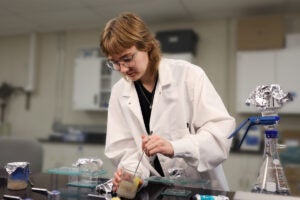AUSTIN, Texas—When David Covarrubias was in high school in Brownsville, he designed a party dress for his sister. A year later, he saw a similar design in The New York Times Magazine.
“I said, I can do this!” Covarrubias remembers, and his career choice was made. Now he’s president of the UT Student Fashion Group, which includes students in both design and merchandising. He’s also a senior in the textiles & apparel division of the department of human ecology at UT Austin.
He spends his days and nights designing apparel, draping fabrics on mannequins, making patterns and sewing ¬ all in preparation for the annual Senior Portfolio fashion show. This year’s exhibition, a free show scheduled for 7:30 p.m. Thursday (April 22) at the Erwin Center, will feature designs by Covarrubias and 13 other seniors.
For Covarrubias and his 13 student colleagues, their final semester at UT will be a fast-paced preparation for life in the real world of apparel design. They have designed and made garments of cotton fabrics for a March 3 show before the Independent Cotton Ginners Association of Texas. They also created and produced garments made of native Texas fibers (cotton, wool and mohair) for a show at the Texas Food & Fibers Commission at the Dallas Apparel Mart April 16.
In addition to the Senior Portfolio presentation, they are generating multiple designs and stitching garments for four other projects. And that’s not all. The students are conducting fashion shows at restaurants and other projects to raise the $5,000-plus needed to pay expenses for the Erwin Center presentation. The show is organized and produced by Eve Nicols, faculty advisor to the students.
The bustling pace for the spring semester will go a long way to making sure the upcoming graduates find employment. Jobs abound worldwide in the apparel industry, according to Nicols, who was trained in London and was a designer in Milan, Italy, before she entered academia.
The final hurdle for the aspiring graduates will be to undergo mock job interviews and to present their portfolios before a panel of professors and apparel industry experts.
As for Covarrubias, he says his dream is to design clothing and sell his garments in his own retail shop. He’s looking at New York, San Francisco, Mexico City, Austin and Brownsville.
Another senior, Jennifer Gucker of Shreveport, La., is interested in fabric design. Like Covarrubias, she drew pictures of garments as a child and asked her grandmother to turn the designs into clothing.
By the time she entered college, Gucker had drifted away from designing and she majored in liberal arts. Then a friend gave her a sewing machine. She took a sewing class and knew that she had rediscovered her childhood passion.
Textiles and apparel design are not the only disciplines offered in the department of human ecology. There also is the highly regarded retail merchandising program and the emerging conservation program, which is geared toward preserving antique clothing.
The division itself has a college of about 3,000 garments dating back to the 1820s ¬ all donated by benefactors. Division Director Dr. Ardis Rewerts said training in garment preservation is becoming increasingly important now that museums are giving more attention to textiles.



